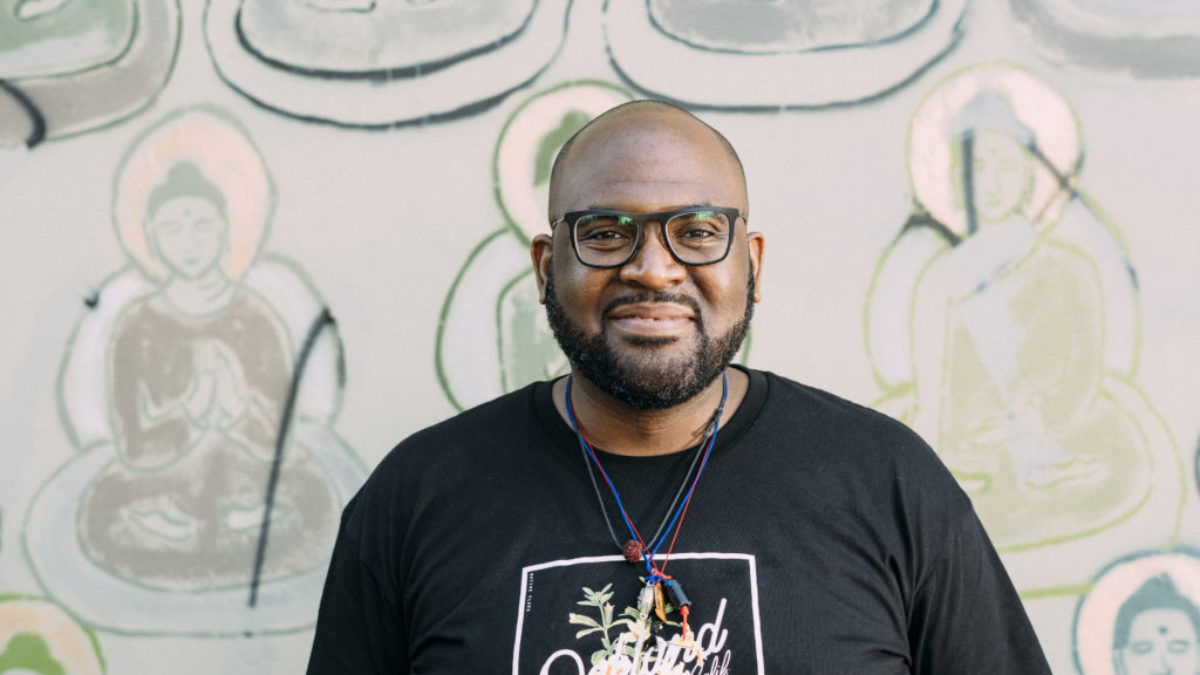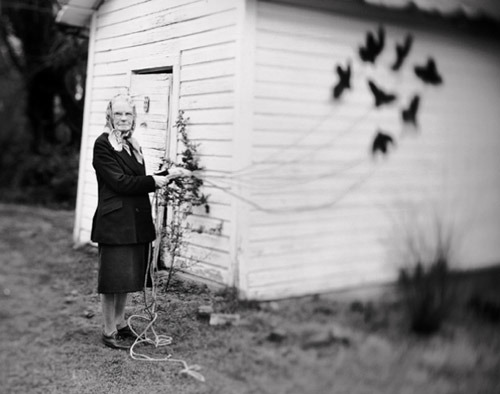Lama Rod Owens is part of a new generation of dharma teachers. Because he’s black, queer and lives in the American south, he brings a different frame to his experiences. His good humour and sharp insights are fully in evidence in his startling and beautiful new book Love and Rage: The Path of Liberation Through Anger. You can find him at www.lamarod.com. This online chitchat excerpt was organized by the inimitable Christi-an Slomka for Calm.
Anger
Anger is an expression of being hurt. Tension arises because we want to take care of ourselves in that moment, but don’t know how. Our reactivity to tension is what actually turns into anger. That’s what many of us would describe as our anger: we’re hurt and unable to take care of ourselves. The reaction to tension is anger.
There’s a misconception that if I meditate really hard I can transcend my feelings, I can turn into anything I want. Unfortunately, the goal of meditation is to get real. To touch the reality of everything, which is a very heartbreaking experience. That’s what we’re trying to avoid, is the heartbreak. When we talk about the mind, when we talk about the body, it’s important that we understand that everything is supposed to be in our experience. One of the goals of meditation is to remember the incredible amount of space in our experience, both the joy and the sadness. Both the bliss and the trauma. Everything altogether. It is the space that allows me to be with everything without being overwhelmed by one thing in particular.
Emotional Labour
Dialoguing about our emotional reality is the work of emotional labour. Emotional labour is done first and foremost for ourselves, for instance the way we might use mindfulness to see and name what our experiences are. Many of us can’t do that. Many of us are moving through the world reacting until someone stops you and asks: “Why are you acting like this? What’s going on?” That’s a prompt. That’s emotional labour that someone is doing for you, prompting you to begin doing emotional labour for yourself. It invites you to find out about what you’re experiencing. We can work through reactivity to find the practice of responding. Responding is an act of self-agency when I’ve done enough emotional labour for myself to hold space for everything.
Meditation
Practice doesn’t begin with anything special, I like to slowly shift attention to certain points in my experience. I begin bringing attention to my seat, noticing the weight of my body making contact with the seat. That sensation of contact is an anchor that holds my attention. In any situation this is where I want to come to, to feel my body in contact with something, to let my body pull me out of reactivity and thoughts.
Once I feel grounded, I turn my attention to the anger. The first thing I want to tell myself is that: “I am angry.” Allow yourself to notice what it feels like. As we transition into the second part, I invite you to begin to tell yourself that this anger is just an experience. Anger is an experience. I am experiencing anger. With that statement I wonder if you can begin to connect to any kind of spaciousness that begins to open. Can you feel something relaxing, that you can relax a little bit, that you feel less contracted? I am experiencing this anger, and allowing this experiencing to open up the space around me.
The next step is actually allowing ourselves to experience the anger itself. What does it feel like? Can you stay in your body? Not all of us can because of the physical traumas we’ve experienced, but if you can go into your body, where is anger showing up? Where do you feel tight or heavy? What feels differently in the body in this moment that we’re working with anger? If physical sensations arise, they’re just an experience. Can you allow that experience to sit within this openness, this space. And it’s from this space that we can move from reactivity to responding. I begin to respond consciously about how to move forward in whatever situation I find myself in, using this practice. We begin to transition out of the practice, and again I love to return to the seat, the contact of my body on the seat. Using that sensation to ground my attention. Sometimes to finish up my practice I like to reflect on something or someone that I’m grateful for. This gratitude allows me to experience some joy, some happiness. Sometimes I just need to remember that there’s something good happening for me in my life and in the world. Our reactivity, our anger, can really swallow up our outlook on the world that’s positive, that’s hopeful. But coming back to gratitude is a reminder that there are relationships I love and appreciate.
The very last thing is to wish that all beings, all people, all animals and plants, have the capacity over time to do this incredible practice, to remember this spaciousness, so they can make different choices in their lives and the world.
When we get really triggered, we need to move our body to get energy circulating, even if it’s just taking a walk. Going outdoors is helpful to let the energy process. That’s a basic practice we can use on the spot. I can do this process very quickly, in a couple of seconds.
The heart of this practice is recognizing everything as an experience that’s moving through my body and mind like clouds passing through the sky.
Trigger
Anger is tied to experiences of physical trauma, it can trigger that energy, sending us back to our oldest and most unwanted experiences, so we have to create a container to take care of ourselves. We don’t want to continue to retrigger ourselves, we want to release that energy, we want to give any experience of trauma lots of space, and give us lots of choice to be in relationship to that trauma. Lots of choice to figure out what to do. That’s why we go slow. I’ve spent a lot of time trying to develop practices where we feel cared for, held and loved. Continuously touching those loving practices help us to lean into really intense emotional energy and feel we’re not doing it alone.
Suffer More?
When we begin paying attention it seems we suffer more. But you’re not, you’re just paying attention to what’s already present. All that hurt has been waiting in the shadows. The practice can feel overwhelming because it’s an introduction to the truth, and it takes time to develop a relationship to that awakening. It takes practice to keep showing up, over and over again, and allowing ourselves bit by bit to experience what we’re paying attention to. Over time, the practice changes the relationship to our wounds.
Compassion
The other practice I rely on is compassion. I know that when someone is angry, there’s hurt. Instead of getting wrapped up in someone else’s anger, I reorient myself to reflect on the hurt they’re feeling in the moment. On the hurt I’ve felt, that has led me to act in the same way sometimes. When I’m just trying to protect myself. And then from that empathy that we’re building we just want them to be free of the suffering. As we want to be free ourselves. That’s the ultimate protection. We move into the hurt because we want all of us to be free. And we’re continually letting go, we’re acknowledging that this fear and pain isn’t mine. Then we can begin to express a more open spacious energy.
Boundaries
Many of us have relationships or are in spaces where we haven’t set enough boundaries. Boundaries are important because they create space for not only ourselves to be protected, but others can be protected from us. (laughs) Boundaries create space for me to practice so I can continue to be in some relationship with the person I’m struggling with. But boundaries are the hardest thing to set. There are times when I should just say, “That’s not ok. This thing you keep doing is really hurtful.” How to say no?
Ocean
This is the fear: that if I allow myself to feel this anger – whether it comes from myself or someone else – then I will be consumed by it. That comes from a perspective or belief that our minds are not boundless. This belief says: the space in our minds cannot hold this anger. But after years of practice I saw that my anger is just another expression of my mind. My mind is a vast ocean and any thought, any emotion that arises out of my mind, is like a wave rising out of the ocean. I call it a wave, but it’s just water that will return to the ocean, like a thought or emotion returns to the space of the mind.
My anger isn’t bigger than me. It feels bigger because the energy is intense and I haven’t developed the space to disrupt reactivity. I haven’t trained enough in remembering the vast spaciousness. When I’m always reacting it feels like I’m always contracting in my mind, it’s like being swallowed. We feel small. We have to break that illusion and relax and expand into spaciousness so that anger becomes only one thing that’s happening in the room. But this is not an overnight practice. It’s easy to say but you have to train over and over again.
The world is full of anger. But anger is not the main event. We are overwhelmed by hurt, grief, disappointment, sadness and sorrow. That’s what is overwhelming us. Anger arises out of feelings I call heartbrokenness. Anger arises because we don’t know what to do with all this discomfort. When I look at the news, I see so much hurt. My role is to help people take care of the hurt.
Empathy
When we connect to the hurt of the world our hearts begin to soften and deeply empathize. We begin to say, “Oh, you’re just like me.” That’s softening. Particularly with people I don’t like. (laughs) When I begin to connect with their discomfort there’s a softening that begins to happen. We begin to embody what being grounded feels like, what emotional labour looks like for ourselves. If we can’t do that we have no hope for creating the change we need to see in the world.
Change begins with ourselves. If I don’t have practice on myself, I become quite limited in what I can do. The anger of the world is overwhelming and scary, our safety is compromised. Holding all of that in my mind I allow into my experience the fear of other people’s anger. I understand the possibility that I won’t survive another person’s anger. That’s just a reality of living. And that reality is death. (laughs) Living always points to our dying. They are intertwined and interrelated. It’s anger and hurt, but it’s also my death. I’m scared of someone’s anger ending my life. How to experience even that fear?
Earlier in my life I was terrified about how I’m going to meet the violence of the world being black and queer, knowing that I was always at risk for discrimination. I didn’t know how I was going to deal with that. When I started meditation it helped me to show up for my life, to actually meet experiences I was terrified of. By allowing them to be there and have space, that completely transformed my survival in spaces I felt threatened in. Yes, the threat is still there for me, absolutely, but my life isn’t coordinated around the fear of those threats any longer. I could make choices. I began to choose happiness and gratitude and also to realize I’m moving through a sometimes dangerous society, and both of those things can happen at the same time.
Everything
So much of anxiety is the worry, the fear we experience around the unknown future. Anxiety expresses a lack of confidence that I can show up to meet whatever arises. This isn’t an overnight practice. My mindfulness practice has helped me to say: whatever happens, happens. Whatever arises, I’m going to trust the practice I’ve been able to cultivate, even if it means having to hold space for my own death. Everything can be held. There’s nothing that will happen in our lives that cannot be held within the space of our minds. We may not believe it. But while meditating, or being mindful, we feel the mind is vast. We’re training to feel the vastness and to see the nature of everything. The nature of everything is spacious and open and empty.
Love Everything
Another practice is training to love everything. I even have to love what is unlovable. I’m training to come back into relationship with everything I run away from, and hold space for that. Even the things I think are impossible to do that with. That’s the level I practice at.


